LAB REPORT
Science and Technology Making Headlines
April 10, 2020
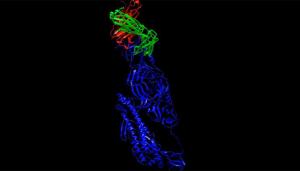
This visualization depicts the 3D structure of an antibody candidate binding to the protein of SARS-CoV-2, the virus that causes COVID-19
A global battle against COVID-19
Researchers racing to develop a vaccine for COVID-19 face an even more urgent task in light of recent reports that the coronavirus has rebounded in Asia despite efforts to tamp it down.
Even with a vaccine, COVID-19 will remain a menace, because researchers are not sure if the virus that causes it could mutate in the years ahead.
“What we don’t know about this virus is what its pace of evolution is,” said David Rakestraw, a chemical physicist who is helping lead the COVID-19 work underway at Lawrence Livermore National Laboratory, which has conducted bioterrorism research for decades. “Don’t expect this to go away soon. The virus is in the population now, and it will evolve.”
The U.S. national laboratory system has roughly 1,000 scientists and doctors at its disposal, and it operates the world’s largest network of supercomputers.
In the Bay Area, Lawrence Livermore is using computer modeling technologies to examine how 26 million different known molecules might bind and destroy the function of the coronavirus.
To do so, scientists built a virtual 3D model of a virus and started examining how a molecule could bind onto the virus, a modeling job that requires computational power that has come online only in recent years, Rakestraw said.

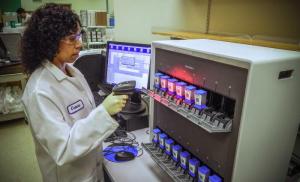
LLNL biomedical scientist Celena Carrillo conducts benchtop experiments that assisted Sunnyvale-based Cepheid in advancing virus detection tests for emergency use. Photo by Julie Russell/LLNL
Mobilizing MEMs to fight COVID-19
The race against time to fight the COVID-19 pandemic has motivated a global flurry of activity and collaboration by technology companies.
On March 21, the U.S. Food and Drug Administration gave emergency authorization to California’s Cepheid to sell a new test for the rapid detection of the SARS-CoV-2 virus, which causes COVID-19.
Cepheid, founded by Kurt Petersen, Allen Northrup and others and originally developed at Lawrence Livermore National Laboratory, has been well known in the MEMS community for commercializing microfluidic chip-based polymerase chain reaction (PCR) analysis machines.
MEMS technology brings two major benefits to PCR: reduced size and microfluidic integration. MEMS-scale heaters and reaction chambers have a tiny thermal mass, which results in a significantly faster heat-cool cycle and a rapid result in minutes.
Development of MEMS PCR chips began back in the early 1990s. LLNL published a paper in 1993 on the first silicon-based PCR chip, which was eventually licensed by Cepheid in 1996. Research continued steadily throughout the decades on how to use MEMS materials and methods to create novel PCR chips and micro total analysis systems (uTAS) from silicon, glass and even plastic substrates.

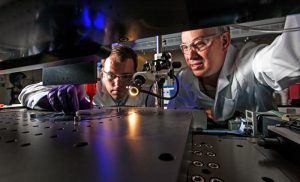
Lawrence Livermore National Laboratory engineers Eric Duoss (left) and Tom Wilson use an additive manufacturing process called direct ink writing to develop an engineered “foam” cushion.
Metamaterials come to a head
3D printing involves changing the physical properties of an object through changes in its microarchitecture. By 3D printing unique microgeometries, one can make a material behave in completely novel ways. The resulting architected materials, also referred to as metamaterials, have several interesting applications across a variety of industries.
The most obvious application in 3D printing is improving the strength-to-weight ratio of an object. But researchers have explored several different physical properties possible with architected materials.
Autodesk and Lawrence Livermore National Laboratory were among the most notable to design an architected material for use in helmet cushioning. By optimizing the microgeometry of a 3D-printed cushion, the team could selectively make regions of a cushion softer and more prone to compression and other regions stiffer.
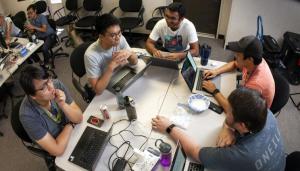
LLNL placed in the top 25 best places to work.
Best of the best
InformationWeek recently updated its annual list of the top technology employers. In keeping things as normal as possible during a time of crisis, those companies that are doing an excellent job of treating their employees well and are receiving top reviews from their employees are recognized as top employers.
This year’s project uses a slightly different methodology than last year. Instead of relying on a single job posting site for the ratings, this year’s list began with the technology firms on Glassdoor’s list of the top 100 employers and then added in ratings from Indeed.com and Comparably. All three websites give employers a rating from one to five, with five being the highest score.
This new methodology resulted in some new employers that hadn’t made the list in past years.
Lawrence Livermore National Laboratory ranked came in at No. 21.

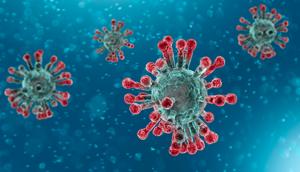
In response to COVID-19, the Lab has transitioned to a Reduced Mission-Critical Operations state.
Lab resumes some mission critical operations
Last week, limited work resumed on site in support of specific mission essential activities, a posture known as “Reduced Mission-Critical Operations.” This process will continue over the next several weeks, with small numbers of employees returning to the Laboratory to gradually resume work. These numbers will increase as part of what ultimately will be a safe, deliberate and orderly return to normal Laboratory operations.
Reduced Mission-Critical Operations primarily include activities in support of national security an COVID-19 research. To enable these efforts, the Lab is gradually calling back select employees. Employees who are not working on site should continue their current posture, whether telecommuting or on authorized leave, until further notice.





